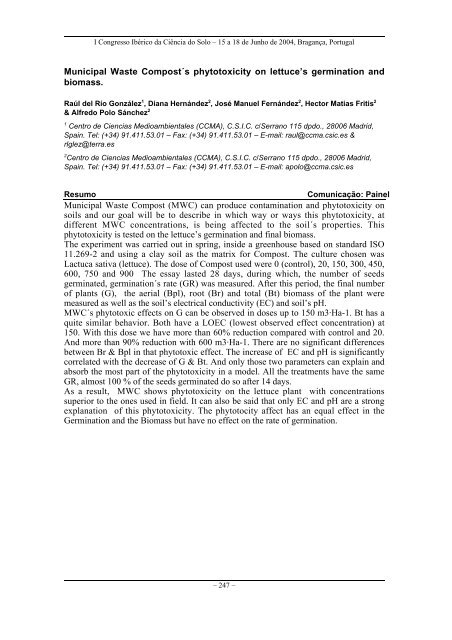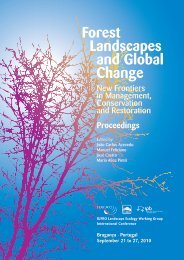Programa e Resumos - I Congresso Ibérico de Ciência do Solo 2004
Programa e Resumos - I Congresso Ibérico de Ciência do Solo 2004
Programa e Resumos - I Congresso Ibérico de Ciência do Solo 2004
You also want an ePaper? Increase the reach of your titles
YUMPU automatically turns print PDFs into web optimized ePapers that Google loves.
I <strong>Congresso</strong> Ibérico da Ciência <strong>do</strong> <strong>Solo</strong> – 15 a 18 <strong>de</strong> Junho <strong>de</strong> <strong>2004</strong>, Bragança, Portugal<br />
Municipal Waste Compost´s phytotoxicity on lettuce’s germination and<br />
biomass.<br />
Raúl <strong>de</strong>l Río González 1 , Diana Hernán<strong>de</strong>z 2 , José Manuel Fernán<strong>de</strong>z 2 , Hector Matias Fritis 2<br />
& Alfre<strong>do</strong> Polo Sánchez 2<br />
1 Centro <strong>de</strong> Ciencias Medioambientales (CCMA), C.S.I.C. c/Serrano 115 dp<strong>do</strong>., 28006 Madrid,<br />
Spain. Tel: (+34) 91.411.53.01 – Fax: (+34) 91.411.53.01 – E-mail: raul@ccma.csic.es &<br />
rlglez@terra.es<br />
2 Centro <strong>de</strong> Ciencias Medioambientales (CCMA), C.S.I.C. c/Serrano 115 dp<strong>do</strong>., 28006 Madrid,<br />
Spain. Tel: (+34) 91.411.53.01 – Fax: (+34) 91.411.53.01 – E-mail: apolo@ccma.csic.es<br />
Resumo<br />
Comunicação: Painel<br />
Municipal Waste Compost (MWC) can produce contamination and phytotoxicity on<br />
soils and our goal will be to <strong>de</strong>scribe in which way or ways this phytotoxicity, at<br />
different MWC concentrations, is being affected to the soil´s properties. This<br />
phytotoxicity is tested on the lettuce’s germination and final biomass.<br />
The experiment was carried out in spring, insi<strong>de</strong> a greenhouse based on standard ISO<br />
11.269-2 and using a clay soil as the matrix for Compost. The culture chosen was<br />
Lactuca sativa (lettuce). The <strong>do</strong>se of Compost used were 0 (control), 20, 150, 300, 450,<br />
600, 750 and 900 The essay lasted 28 days, during which, the number of seeds<br />
germinated, germination´s rate (GR) was measured. After this period, the final number<br />
of plants (G), the aerial (Bpl), root (Br) and total (Bt) biomass of the plant were<br />
measured as well as the soil’s electrical conductivity (EC) and soil’s pH.<br />
MWC´s phytotoxic effects on G can be observed in <strong>do</strong>ses up to 150 m3·Ha-1. Bt has a<br />
quite similar behavior. Both have a LOEC (lowest observed effect concentration) at<br />
150. With this <strong>do</strong>se we have more than 60% reduction compared with control and 20.<br />
And more than 90% reduction with 600 m3·Ha-1. There are no significant differences<br />
between Br & Bpl in that phytotoxic effect. The increase of EC and pH is significantly<br />
correlated with the <strong>de</strong>crease of G & Bt. And only those two parameters can explain and<br />
absorb the most part of the phytotoxicity in a mo<strong>de</strong>l. All the treatments have the same<br />
GR, almost 100 % of the seeds germinated <strong>do</strong> so after 14 days.<br />
As a result, MWC shows phytotoxicity on the lettuce plant with concentrations<br />
superior to the ones used in field. It can also be said that only EC and pH are a strong<br />
explanation of this phytotoxicity. The phytotocity affect has an equal effect in the<br />
Germination and the Biomass but have no effect on the rate of germination.<br />
– 247 –
















